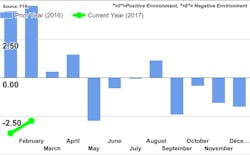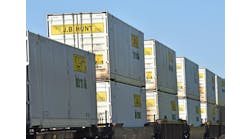The Shippers Conditions Index (SCI), a monthly compilation of factors affecting the shippers transport environment reported by transportation forecasting firm FTR, improved somewhat in February 2017. The problem is, even with a gain of 0.8 over January February’s score of -3.6, the current SCI score of -2.8 is worse than any monthly score registered in 2016 (see chart below).
For the SCI, any reading below zero indicates a less-than-ideal environment for shippers. And while February’s reading is slightly better than January’s, FTR expects a tightening market late in the year, with an expected increase in freight demand as economic growth improves.
The SCI compiles four key metrics into a singular view of how the market is operating: freight demand, transport utilization levels, transport costs and fuel pricing, explains Jonathan Starks, chief operating officer at FTR. “In February, there was little change in most of these metrics aside from fuel pricing. Diesel fuel prices dropped a slight amount in February after jumping 7 cents in January, and the outlook for pricing is for relative stability during most of 2017.”
The biggest drag on the index, Starks notes, continues to be the impact of the tightening capacity environment that has emerged over the last 9 to 12 months. “The spot market gives us a quick indication of this tightening, with the Market Demand Index (MDI) from Truckstop.com up more than 80% versus February 2016.”
Another transportation index—the Cass Freight Index, compiled by Cass Information Systems Inc.—echoes the SCI in its anticipation of an improved economic outlook. For the month of March 2017, freight shipments in the U.S. were up 0.5% over January, and 0.9% year-over-year. Meanwhile, freight expenditures were down -1.2% compared to last month, but up 3.0% year-over-year.
The improvement in shipment volumes, according to Donald Broughton, senior transportation analyst with Avondale Partners, is largely due to parcel volumes associated with e-commerce, which he says continues to show “outstanding rates of growth, with both FedEx and UPS reporting strong U.S. domestic volumes.” Airfreight has also been strong, particularly in Europe, which indicates that “the improving trends in the freight economy are not confined to the U.S., he notes.
Broughton also reports that rail volumes, which have been the weak link in freight volumes over the past two years, “have become increasingly less bad.” As for trucking, while recent trucking industry data released by the American Trucking Associations showed trucking gaining momentum, “recent tepid results by brick-and-mortar retailers appear to be taking their toll,” he says.




